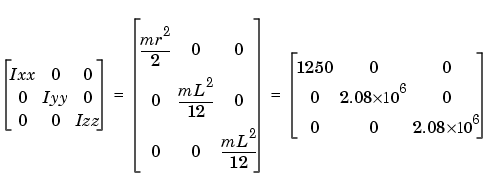

| SimMechanics |   |
Configuring a Body Block
While you need at least one Ground block to make a machine model, a real machine consists of one or more rigid bodies. So you need to translate the components of a real machine into block representations. This section explains how you use a Body block to represent each rigid body in your machine:
Although the body is the most complicated component of a machine, SimMechanics does not use the full geometric shape and mass distribution of the body. SimMechanics only needs certain mass properties and simplified geometric information about the body's center of gravity, its orientation, and the coordinate systems attached to the body.
Setting these properties sets the body's initial conditions of motion, if you do nothing else to the Body block or its connected Joints before simulating.
Characteristics of a Body Block
The main characteristics of a Body block are its mass properties, its position and orientation in space, and its attached Body coordinate systems (CSs).
The mass properties include the mass and inertia tensor. The mass is a real, positive scalar. The inertia tensor is a real, symmetric 3-by-3 matrix. It does not have to be diagonal.
The position of the body's center of gravity (CG) and orientation relative to some coordinate system axes indicate where the body is and how it is rotated. These are the body's initial conditions during construction of the model and remain so when you start the simulation, unless you change them before starting.
The attached Body CSs (their origins and coordinate axes) are fixed rigidly in the body and move with it. The minimum CS set is one, the CS at the CG (the CG CS), with its CS origin at the center of gravity of the body. The default CS set is three, the CG CS and two additional CSs called CS1 and CS2 for connecting to Joints on either side. See the next section, Configuring a Joint Block.
Beyond the minimum CS at the CG, you can attach as many Body CSs on one Body as you want. You need a separate CS for each connected Joint, Constraint, or Driver and for each attached Actuator and Sensor.
The inertia tensor components are interpreted in the CG CS, setting the orientation of the body relative to the CG CS axes. The orientation of the CG CS axes relative to the World axes then determines the absolute initial orientation of the body. Since the CG CS axes remain rigidly fixed in the body during the simulation, this relative orientation of the CG CS axes and the body does not change during motion. The inertia tensor components in the CG CS also do not change. As the body rotates in inertial space, however, the CG CS axes rotate with it, as measured by the absolute World axes.
Properties of the Simple Pendulum Body
The simple pendulum is a uniform, cylindrical steel rod of length 1 meter and diameter 2 cm. The initial condition is the rod lying parallel to the negative x-axis, horizontal in the gravity field. One end of the rod, the fixed pivot for the rod to swing, is located at the ground point (3,4,5). Its coordinate system is called CS1. The center of gravity and the origin of the CG CS is the geometric center of the rod. Take the CG CS axes to be parallel to the World axes as you set up the pendulum.
Uniform steel has density  = 7.93 gm/cc (grams per cubic centimeter). In the CG CS here, the inertia tensor I is diagonal, and Izz controls the swinging about the z-axis, in the x-y plane. The inertia tensor is always evaluated with the origin of coordinates at the CG. For a rod of length L = 1 m and radius r = 1 cm, the mass m =
= 7.93 gm/cc (grams per cubic centimeter). In the CG CS here, the inertia tensor I is diagonal, and Izz controls the swinging about the z-axis, in the x-y plane. The inertia tensor is always evaluated with the origin of coordinates at the CG. For a rod of length L = 1 m and radius r = 1 cm, the mass m = 
 r2L = 2490 gm (grams), and the inertia tensor I reads
r2L = 2490 gm (grams), and the inertia tensor I reads

in gm-cm2 (gram-centimeters2). The x-axis is the cylinder's symmetry axis. Thus Iyy = Izz.
The mass and geometric properties of the body are summarized in the following table and depicted in Figure 2-2.
| Property |
Value |
| Mass (gm) |
2490 |
| Inertia tensor (kg-m2) |
[1.25e-4 0 0; |
| CG Position/Origin (m) |
[ 2.5 4 5 ] |
| CS1 Origin (m) |
[ 3 4 5 ] |
 | The World Coordinate System and Gravity | Configuring the Body Dialog |  |